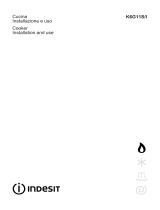
10
This position is recommended for finishing off the cooking
of food (in baking trays) which is already superficially
well-cooked but still soft inside.
Note that when using this position, the thermostat is
automatically set at the maximum temperature which
cannot be regulated.
Upper heating element
Set the termostat knob (C) between 50°C and 250°C.
By turning the knob to this position, the oven light and
upper heathing element come on.
This position is recommended for finishing off the cooking
of food (in baking trays) which is already inside well-
cooked but still soft superficially.
Grill
Important: do not set the thermostat knob "C" to over
200°C. During grilling, keep the oven door closed.
Both of the central heating element of the grill are
activated. Food is cooked in the grill by the downward
thermal rays produced by an incandescent electric
heating element. The high, direct grill temperature
immediately browns meat, thus stopping juice dispersion
and keeping meat more tender. The grill is particularly
recommended for cooking dishes requiring a high
superficial temperature: beef and veal steaks, entrecote,
fillet steaks, hamburgers etc...
Ventilated Grill
Important: do not set the thermostat knob "C" to over
200°C. During grilling, keep the oven door closed.
Both of the central heating element of the grill are
activated, as well as the fan. This combination of features
increases the effectiveness of the thermal radiation of
the heating elements through forced air circulation of
the air throughout the oven. This helps prevents foods
from burning on the surface, allowing the heat to pene-
trate into the food.
"Gentle pastry oven"
Set the termostat knob (C) between 50°C and 250°C.
The lower heating element and the fan come on.
This setting is ideal when cooking delicate foods,
especially pastries that need to raise, because the heat
rising from the bottom facilitates leavening. Please note
that with this feature it takes a rather long time to reach
higher temperatures in the oven. Therefore, if high
temperatures are needed, we recommend that you use
the "Conventional" setting.
Ventilation Mode
Set the thermostat knob (C) between 50°C and 250°C.
Both the heating elements and the fan will come on. Since
the heat remains constant and uniform throughout the
oven, the air cooks and browns food uniformly over its
entire surface. With this mode, you can also cook various
dishes at the same time, as long as their respective
cooking temperatures are the same. A maximum of 2
rack levels can be used at the same time, following the
instructions in the section entitled, "Cooking On More
Than One Rack". This cooking mode is ideal for au
gratin dishes or those which require an extended cooking
time.
Moreover, the excellent heat distribution makes it
possible to use lower temperatures when cooking roasts.
This results in less loss of juices, meat which is more
tender and a decrease in the loss of weight for the roast.
The ventilated mode is especially suited for cooking fish,
which can be prepared with the addition of a limited
amount of condiments, thus maintaining their flavor and
appearance. The ventilated mode can also be used to
thaw white or red meat, fish and bread by setting the
temperature to 80°-100°C. To thaw more delicate foods,
set the termostat to 60°C or use only the cold air
circulation feature by setting the thermostat to 0°C.
After cooking, turn the appliance on for 4-5 minutes,
setting the temperature knob to 0 in order to allow the
oven to cool. If the appliance has been on for an
extended amount of time at maximum temperature and
this advice is not taken, a safety device to protect the
same is activated, which interrupts the electricity
supply temporarily.
The thermostat light (E)
This indicates that the oven is heating up. When the light
goes out, the required temperature has been reached.
When the light alternately comes on and goes out, it
means that the thermostat is working properly to maintain
the oven temperature.
Multi-Skewer Rotisserie
The Maxiovens are equipped with a removable multiple
skewer rotisserie positioned parallel to the back of the
oven fig. A). Slide the meat to be cooked onto the spit
lengthwise, keeping it in place with the adjustable forks.
With kebabs, slide the meat to be cooked onto the
skewers provided and place them on the appropriate
holders.
Slide the holders, "A" and "B" in Fig. A, into the
appropriate holes in the dripping-pan, rest the groove
end of the rod on the guide "D" and slide the rack onto
the bottom guide (Fig. B). Then slid the rod into the hole
for the motor shaft and place the grooved end of the rod
on the guide "C."
Start the motor by turning the knob to the grill setting
.
AB
Fig. B
Fig. A
How To Use Your Appliance










